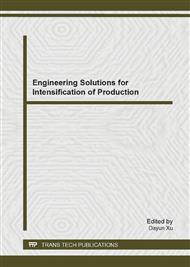[1]
Gang Chen, Wei-gong Zhang, Xiao-na Zhang: Speed Tracking Control of Vehicle Robot Driver System Using Multiple Sliding Surface Control Schemes. International Journal of Advanced Robotic Systems. Vol. 10 (2013), pp.1-9.
DOI: 10.5772/53750
Google Scholar
[2]
Gang Chen, Wei-gong Zhang, Xiao-na Zhang: Fuzzy Neural Control for Unmanned Robot applied to Automotive Test. Industrial Robot-An International Journal. Vol. 40 No. 5 (2013), pp.450-461.
DOI: 10.1108/ir-08-2012-398
Google Scholar
[3]
Xiaobing Chen and Weigong Zhang: Robot driver for vehicle durability emission test on chassis dynamometer. Journal of Southeast University (English Edition). Vol. 21 No. 7 (2005), pp.33-38.
Google Scholar
[4]
M Spencer, D Jones, M Kraehling and K Stol: Trajectory based autonomous vehicle following using a robotic driver. in Robotics and Automation in 2009 proceedings of the Australasian Conference in Sydney, Australia. (2009), pp.1-10.
Google Scholar
[5]
Fuen Chen, Chunfu Gao, Lunan Duan, et al: Test System of Capability and Life-span of Auto Synchronizer and Its Control of Handling Mechanical Hand. Chinese Journal of Construction Machinery. Vol. 2 No. 1 (2004), pp.108-112.
Google Scholar
[6]
Weigong Zhang, Yujian Zhai and Jiangsheng Ni: Design optimization of gear shifting manipulator in vehicle robot driver. China Mechanical Engineering. Vol. 6 No. 1 (1995), pp.36-38.
Google Scholar
[7]
Nicholas Wong, Christopher Chamber, Dr Karl Stol, et al: Autonomous Vehicle Following Using a Robotic Driver. 15th International conference on Mechatronics and Machine Vision in Practice (M2VIP08), Auckland, New-Zealand. (2008), pp.115-120.
DOI: 10.1109/mmvip.2008.4749517
Google Scholar
[8]
Oriol Gomis-Bellmunt, Samuel Galceran-Arellano, Antoni Sudrià-Andreu, et al: Linear electromagnetic actuator modeling for optimization of mechatronic and adaptronic systems. Mechatronics. Vol. 17 No. 2-3 (2007), pp.153-163.
DOI: 10.1016/j.mechatronics.2006.07.002
Google Scholar
[9]
Rajesh Luharuka, Saniya Le Blanc, Jemmy S. Bintoro: Simulated and experimental dynamic response characterization of an electromagnetic micro valve. Sensors and Actuators. Vol. 143 No. 2 (2008), pp.399-408.
DOI: 10.1016/j.sna.2007.10.084
Google Scholar
[10]
State Environmental Protection Administration of China: GB 18352. 3-2005 Limits and measurement methods for emissions from light-duty vehicle (III, IV). Beijing: Standards Press of China. (2005).
Google Scholar
[11]
Chen Gang, Zhang Weigong, Gong Zongyang, et al: A Vehicle Performance Self Learning Method Applied to Robot Driver. China Mechanical Engineering. Vol. 21, No. 4 (2010), pp.491-495.
Google Scholar


